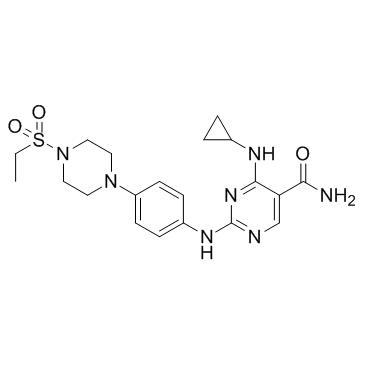1198300-79-6
| Name | 4-(cyclopropylamino)-2-(4-(4-(ethylsulfonyl)piperazin-1-yl)phenylamino)pyrimidine-5-carboxamide |
|---|---|
| Synonyms |
5-Pyrimidinecarboxamide, 4-(cyclopropylamino)-2-[[4-[4-(ethylsulfonyl)-1-piperazinyl]phenyl]amino]-
4-(Cyclopropylamino)-2-({4-[4-(ethylsulfonyl)-1-piperazinyl]phenyl}amino)-5-pyrimidinecarboxamide PRT-062070 cerdulatinib |
| Description | Cerdulatinib (PRT062070) is a dual JAK and SYK inhibitor with IC50s of 12, 6, 8 and 32 for JAK1, 2, 3 and SYK, respectively. |
|---|---|
| Related Catalog | |
| Target |
Tyk2:0.5 nM (IC50) JAK2:6 nM (IC50) JAK3:8 nM (IC50) JAK1:12 nM (IC50) Syk:32 nM (IC50) MST1:4 nM (IC50) ARK5:4 nM (IC50) MLK1:5 nM (IC50) FMS:5 nM (IC50) AMPK:6 nM (IC50) TBK1:10 nM (IC50) MARK1:10 nM (IC50) PAR1B-a:13 nM (IC50) TSSK:14 nM (IC50) MST2:15 nM (IC50) GCK:18 nM (IC50) JNK3:18 nM (IC50) Rsk2:20 nM (IC50) Rsk4:28 nM (IC50) CHK1:42 nM (IC50) Flt4:51 nM (IC50) Flt3:90 nM (IC50) Ret:105 nM (IC50) Itk:194 nM (IC50) |
| In Vitro | Cerdulatinib shows inhibitory effect on 60 CLL with IC50 ranging from 0.37 to 10.02 µM. Cerdulatinib induces apoptosis in CLL in association with MCL-1 down-regulation and PARP cleavage. Cerdulatinib (2μM) is able to overcome the support of the microenvironment and induces CLL cell death. Cerdulatinib (250-500 nM) blocks proliferation of ibrutinib-sensitive and ibrutinib-resistant primary CLL cells. Cerdulatinib also blocks proliferation of both ibrutinib-sensitive and ibrutinib-resistant primary CLL cells as well as BTKC481S-transfected cell lines, and blocks BCR and JAK-STAT signaling pathways. Furthermore, inhibition of SYK and JAK by cerdulatinib translates to downstream inhibition of AKT and ERK. Cerdulatinib inhibits the activity of NF-kB pathway[1]. PRT062070 reduces the ability of stimulated B cells to upregulate cell-surface expression of the early activation marker CD69 (IC50=0.11 µM). PRT062070 exhibits differential potency against cytokine JAK/STAT signaling pathways. PRT062070 (1 or 3 µM) induces apoptosis in BCR-signaling competent NHL cell lines[2]. Cerdulatinib demonstrates inhibitory activity against both ABC and GCB subtypes of DLBCL cells. Cerdulatinib also induces apoptosis in both GCB and ABC subtypes of DLBCL cell lines via caspase 3 and PARP cleavage. And cerdulatinib blocks cell cycle in both ABC and GCB subtypes of DLBCL via inhibition of RB phosphorylation and down-regulation of cyclin E. Cerdulatinib induces cell cycle arrest and apoptosis under the condition of BCR stimulation in all DLBCL cell lines. Besides, cerdulatinib blocks JAK/STAT and BCR signaling in both ABC and GCB DLBCL cell lines. Cerdulatinib induces cell death in primary human DLBCL samples[3]. Cerdulatinib inhibits BCR-induced signals in a dose-dependent manner and most strongly between 0.3 to 1 μM. and particularly in IGHV-unmutated samples with greater BCR signaling capacity and response to IL4, or samples expressing higher levels of sIgM, CD49d+, or ZAP70+. Cerdulatinib overcomes anti-IgM, IL4/CD40L, or NLC-mediated protection by preventing upregulation of MCL-1 and BCL-XL; however, BCL-2 expression is unaffected. Furthermore, in samples treated with IL4/CD40L, cerdulatinib synergizes with venetoclax in vitro to induce greater apoptosis than either drug alone[4]. |
| In Vivo | PRT062070 (0.5 mg/kg) results in a nonstatistically significant trend toward reduced ankle inflammation, whereas significant reductions in inflammation are achieved with the 1.5, 3, and 5 mg/kg doses. PRT062070 also affects anticollagen antibody formation. PRT062070 (15 mg/kg) suppresses upregulation of splenic B-cell surface CD80/86 and CD69, and inhibits BCR signaling and activation in the spleen after oral dosing in mice[2]. |
| Cell Assay | TMD8 cells are transfected with constructs of WT BTK or BTKC481S mutants using kit V, Program U-13 on Amaxa Nucleofector. After transfection, the cells are co-cultured with NKTert cells in a 24-well plate for 24 hrs for recovery. Ibrutinib, cerdulatinib and vehicle (DMSO) are then added into the transfected TMD8 cells and cellular viability is determined with MuseTM Count & Viability kit using Muse Cell Analyzer. The cell survival is determined by flow cytometry using the Annexin V/7-AAD Apoptosis Detection Kit I on freshly isolated CLL cells. |
| References |
| Density | 1.4±0.1 g/cm3 |
|---|---|
| Boiling Point | 741.9±70.0 °C at 760 mmHg |
| Molecular Formula | C20H27N7O3S |
| Molecular Weight | 445.539 |
| Flash Point | 402.5±35.7 °C |
| Exact Mass | 445.189606 |
| PSA | 141.93000 |
| LogP | 0.37 |
| Vapour Pressure | 0.0±2.5 mmHg at 25°C |
| Index of Refraction | 1.683 |
| Storage condition | 2-8℃ |
